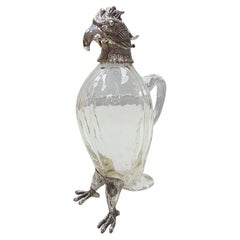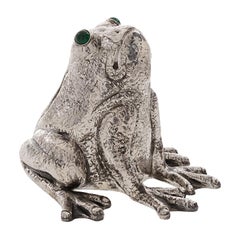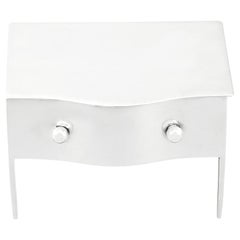Mauro Fancelli Serveware, Ceramics, Silver and Glass
to
1
1
1
1
1
1
1
1
1
1
1
1
1
1
1
646
476
440
398
Creator: Mauro Fancelli
20th Century Italia Solid Silver-Cristal Jug with the Shape of a Parrot
By Mauro Fancelli
Located in VALENZA, IT
Jug with the shape of a parrot. The body is in crystal while the head is the legs are in silver.
The head of the parrot is fixed to the neck with a hinge. This is to allow the liqui...
Category
1990s Italian Other Mauro Fancelli Serveware, Ceramics, Silver and Glass
Materials
Crystal, Silver
Related Items
The Frog Sterling Silver Lighter
By Fratelli Lisi
Located in Milan, IT
Playful true to life silver frog that serves as a lighter other than being a decorative piece of artwork. Expertly handmade by the Florentine silversmiths, the Lisi Brothers, its rea...
Category
2010s Italian Mauro Fancelli Serveware, Ceramics, Silver and Glass
Materials
Sterling Silver
20th Century Edwardian Sterling Silver Jewelry Box
By A&J Zimmerman Ltd.
Located in Jesmond, Newcastle Upon Tyne
An exceptional, fine and impressive antique Edwardian English sterling silver jewelry box; an addition to the ornamental silverware collection
This exceptional antique silver jewelry box, in sterling standard, has been modelled in the form of a dressing table.
The surface of this Edwardian jewelry box is plain and embellished with two applied sterling silver balls to the anterior convex arched surface, replicating the details of the draw handles.
The original hallmarked hinged cover is plain and parallels the shape of the body, opening to reveal the original segmented velvet interior.
The weighted base of this exceptional antique box retains the original leatherette covering to the underside.
The box is supported by four subtly tapering pillar style legs
Note: The majority of such boxes have a wood lining to the interior; it is a sign of quality when boxes have unlined interiors in addition to a solid silver cover.
Condition
This antique silver box is an exceptional gauge of silver, exceptional quality and in exceptional presentation condition.
The box has been professionally polished and is in presentation condition.
The original interior and leatherette covering have wear in keeping with age and use.
Full hallmarks struck to the surface of the body and part hallmarks to the interior of the cover are all very clear.
Reflections in photographs may detract from the true representation of this piece of antique Edwardian jewelry...
Category
Early 1900s English Edwardian Antique Mauro Fancelli Serveware, Ceramics, Silver and Glass
Materials
Silver, Sterling Silver
Parrot Bird Carved Stone Sculpture on Amethyst
Located in New York, NY
Highly realistic and detailed sculpture of a parrot with gilt silver legs perched on an amethyst base. This beautiful piece measures 6 1/3'' in height by 3 3/4'' in depth by 4 1/4'' in width.
We hand polish all items...
Category
20th Century Mauro Fancelli Serveware, Ceramics, Silver and Glass
Materials
Stone, Amethyst, Silver, Sterling Silver
Pair of Porcelain Parrots Signed Meissen, Germany, Early 20th Century
By Meissen Porcelain
Located in Buenos Aires, Buenos Aires
Pair of porcelain parrots signed Meissen. Germany, early 20th century.
Category
Early 20th Century German Belle Époque Mauro Fancelli Serveware, Ceramics, Silver and Glass
Materials
Porcelain
$8,000 Sale Price / set
20% Off
H 9.06 in W 5.91 in D 4.34 in
19th Century German Extremely Detailed Sterling Silver and Gold Gilt Knight
Located in North Miami, FL
19th Century German extremely detailed sterling silver and gold gilt knight figure. Knight in full suit of armour, carved face beneath a hinged viso...
Category
19th Century German Antique Mauro Fancelli Serveware, Ceramics, Silver and Glass
Materials
Stone, Sterling Silver
$7,995
H 12 in W 4 in D 4 in
Attributed to Buccellati, 20th Century Sterling Silver Capercaillie
By Buccellati
Located in North Miami, FL
Presenting a remarkable 20th-century silver capercaillie sculpture, exquisitely attributed to the distinguished Buccellati workshop. This piece captures the essence of the capercaill...
Category
20th Century Italian Mauro Fancelli Serveware, Ceramics, Silver and Glass
Materials
Stone, Sterling Silver
19th Century Italian Sterling Silver Madonna, circa 1830
Located in Milano, IT
Embossed and engraved silver plaque
La Madonna del lago (The Madonna of the Lake)
Probably Milan, post 1824
Brass frame
It measures 16.14 in x 13.85 in (41 x 35.2 cm) and it weighs 10.357 pounds (4.698 g): silver 1.31 pounds (598 g) + brass 9.03 pounds (4.100 g)
State of conservation: some abrasions on the bottom. The frame is old, but not original.
The plaque is made up of a sheet of embossed and engraved silver, and held in a solid brass frame. It depicts the “Madonna del lago” – “Madonna of the Lake” - (the Madonna with Child and San Giovannino) by Marco d'Oggiono (Oggiono, 1474 circa - Milan, 1524 circa), while changing only the background landscape. Almost certainly the subject reproduced in the plaque was taken from a famous engraving by Giuseppe Longhi (Monza, 1766 - Milan, 1831), one of the greatest engravers of his era.
The silver is unmarked, probably because originally the Madonna was due to be exposed in a church: sometimes precious metals destined for worship and liturgical use would be exempted from payment and were, therefore, not marked.
It is very likely that the plaque was made in Milan because in this city in 1824 the engraving by Giuseppe Longhi was made and printed. In addition, in Milan, the alleged lost painting by Leonardo da Vinci in his Milanese period (1482-1500) would be produced; this is the painting from which Marco d'Oggiono took his version.
The painting
Marco d?Oggiono was one of Leonardo da Vinci's most brilliant students and collaborators (D. Sedini, Marco d’Oggiono, tradizione e rinnovamento in Lombardia tra Quattrocento e Cinquecento, Roma 1989, pp. 151-153, n. 56; p. 225, n. 124, with previous bibliography). His style reflects in every way that of the Tuscan Maestro, so much so that he was the one who executed some copies of da Vinci's paintings. The execution of the “Madonna del Lago” probably draws inspiration from a lost painting by the Maestro, created while he was living in Milan (1482-1500). There are many similarities with other works by Leonardo such as the “Vergine delle rocce” or the “Vergine con il Bambino e San Giovannino, Sant’Anna e l’Agnello”.
The painting, from which the drawing and then the famous engraving were taken, is found today at the M&G Museum of Bob Jones University in Greenville, South Carolina, where it came to rest after the sale of the Harrington Collection in London in 1917.
The work appears in the inventories of the collection of Napoleon and Joséphine Bonaparte at the castle of Malmaison, before 1809.
The Malmaison building was born and developed in the 17th and 18th centuries. In the 18th century it belonged to Jacques-Jean Le Coulteux du Molay, a wealthy banker. Later, during the Directory, Joséphine Bonaparte de Beauharnais bought it on April 21st, 1799, but settled at the castle definitively only after her husband separated from her in 1809. She remained there until 1814, the year of her death. When Joséphine died, the estate passed to her son Eugène de Beauharnais, who moved to Munich with his whole family in 1815, bringing with him the collection of paintings he inherited from his mother. Eugène died in 1824 and his wife Augusta of Bavaria (von Bayern), unable to keep it, in 1828 sold the Malmaison to the Swedish banker Jonas-Philip Hagerman.
It is likely that in this period Augusta also sold part of the paintings inherited from her husband, including the “Madonna del Lago”. This painting then came into the possession of Leicester Stanhope, fifth Earl of Harrington (1784 - 1862) and then was passed down to his descendants.
In 1917, at the death of Charles, eighth Earl of Harrington, his brother Dudley inherited the title and properties and he put up a part of his collections for sale. Among these, precisely, the painting by Marco d'Oggiono was to be found.
On the occasion of that auction the painting was presented as a work by Cesare da Sesto, by virtue of a handwritten note by the Countess of Harrington on the back of the table. However, already in 1857, the German critic Gustav Waagen had identified Marco d'Oggiono as the author of the painting, then exhibited in the dining room of Harrington House in London (Treasures of Art in Great Britain, in 4 volumes, London, 1854 and 1857).
The engraving
Giuseppe Longhi was one of the most renowned engravers in Italy between the end of the 18th century and the first quarter of the 19th century.
In 1824 Giuseppe Longhi, based on a design by Paolo Caronni, made a famous engraving of the painting of Marco d?Oggiono. The activity of Longhi was then at the peak of his notoriety, enough to earn him very substantial commissions; it is not risky to suppose that some of his successful engravings were also reproduced using other means: in our case in silver. (A. Crespi, a cura di, Giuseppe Longhi 1766–1831 e Raffaello Morghen...
Category
1820s Italian Neoclassical Antique Mauro Fancelli Serveware, Ceramics, Silver and Glass
Materials
Sterling Silver, Brass
Pair of 20th Century Silver Pheasants
Located in Los Angeles, CA
Pair of 800 silver pheasants. Gold vermeil. European (probably Austria).
Category
Early 20th Century Austrian Mauro Fancelli Serveware, Ceramics, Silver and Glass
Materials
Silver
Volkstedt Porcelain Model of a Parrot, German, Early 20th Century
By Aelteste Volkstedter Porzellanmanufaktur
Located in London, GB
A Volkstedt porcelain model of a parrot
German, early 20th century
Measures: height 14cm, width 13cm, depth 6cm
This bold, bright, and beautiful porcelain bird model of a parrot...
Category
Early 20th Century German Mauro Fancelli Serveware, Ceramics, Silver and Glass
Materials
Porcelain
$2,446
H 5.52 in W 5.12 in D 2.37 in
20th Century, Royal Wedding Solid Silver Wager Cup, London, c.1973
Located in Royal Tunbridge Wells, Kent
Novelty 20th century solid silver wager / marriage cup, the cups design inspired by the early 16th century German example, modelled as a female figure sup...
Category
20th Century British Mauro Fancelli Serveware, Ceramics, Silver and Glass
Materials
Silver
$1,352
H 8.27 in W 4.73 in D 2.76 in
Young woman with jug, Carrara marble, signed Bonnal, early 20th century
Located in NICE, FR
Charming sculpture of a young woman carrying a jug, signed by Bonnal on the back and inspired by “Rebecca at the Well” by 19th-century Italian School artist Guglielmo Pugi.
The sculpture in fine white Carrara marble, created between the end of the 19ᵉ century and the beginning of the 20ᵉ century, depicts a pensive, lascivious young woman dressed in the fashion of the turn of the century: she wears a turban from which escapes curls of hair and a bracelet characteristic of the period; the cut of her dress is also very elaborate for a simple peasant woman. The finely embroidered motifs on the dress and turban are further evidence of the sculptor's mastery.
A delicate, feminine piece that will look great in a hallway or on a dressing table, and will make a lovely gift for an aesthete woman.
Guglielmo Pugi lived in Florence, where he ran a sculpture workshop with his two sons. Their workshop, “Guglielmo Pugi e Figli”, was mainly dedicated to exports, particularly to the United States. Guglielmo Pugi's work, emblematic of the Art Nouveau style, is characterized by direct carving in alabaster and Carrara marble (often white or veined).
Some of his sculptures are now housed in Volterra's Historical Alabaster Museum. Many of his works were shown at major international exhibitions, such as the 1901 Pan-American Exposition in Buffalo and the 1904 Exposition...
Category
Early 1900s Art Nouveau Antique Mauro Fancelli Serveware, Ceramics, Silver and Glass
Materials
Marble
$3,433
H 23.23 in W 6.3 in D 5.91 in
20th Century Sterling Silver Bread Dish
Located in Jesmond, Newcastle Upon Tyne
An exceptional, fine and impressive antique George V English sterling silver bread dish; an addition to our dining silverware collection.
This exceptional antique sterling silver ...
Category
20th Century English Mauro Fancelli Serveware, Ceramics, Silver and Glass
Materials
Silver, Sterling Silver
Mauro Fancelli serveware, ceramics, silver and glass for sale on 1stDibs.
Mauro Fancelli serveware, ceramics, silver and glass are available for sale on 1stDibs. These distinctive items are frequently made of stone and are designed with extraordinary care. There are many options to choose from in our collection of Mauro Fancelli serveware, ceramics, silver and glass, although silver editions of this piece are particularly popular. If you’re looking for additional options, many customers also consider serveware, ceramics, silver and glass by Argenteria Etruria, Cesani Virginio, and Arval Argenti Valenza. Prices for Mauro Fancelli serveware, ceramics, silver and glass can differ depending upon size, time period and other attributes — on 1stDibs, these items begin at $2,892 and can go as high as $2,892, while a piece like these, on average, fetch $2,892.


